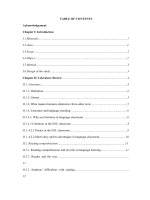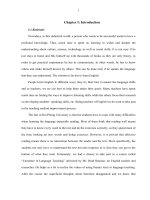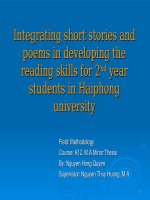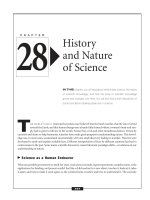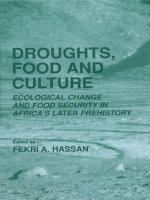Developing pck for an explicit nature of science for vietnamese university students in physics teacher education
Bạn đang xem bản rút gọn của tài liệu. Xem và tải ngay bản đầy đủ của tài liệu tại đây (5.25 MB, 267 trang )
DEVELOPING PCK FOR AN EXPLICIT NATURE OF
SCIENCE FOR VIETNAMESE UNIVERSITY STUDENTS IN
PHYSICS TEACHER EDUCATION
MRS. THI PHUONG THAO DO
A THESIS FOR THE DEGREE OF DOCTOR OF PHILOSOPHY
KHON KAEN UNIVERSITY
2015
DEVELOPING PCK FOR AN EXPLICIT NATURE OF
SCIENCE FOR VIETNAMESE UNIVERSITY STUDENTS IN
PHYSICS TEACHER EDUCATION
MRS. THI PHUONG THAO DO
A THESIS SUBMITTED IN PARTIAL FULFILLMENT OF THE
REQUIREMENTS FOR THE DEGREE OF
DOCTOR OF PHILOSOPHY IN SCIENCE EDUCATION
GRADUATE SCHOOL KHON KAEN UNIVERSITY
2015
THESIS APPROVAL
KHON KAEN UNIVERSITY
FOR
DOCTOR OF PHILOSOPHY
IN SCIENCE EDUCATION
Thesis Title:
Developing PCK for an Explicit Nature of Science for Vietnamese
University Students in Physics Teacher Education
Author: Mrs. Thi Phuong Thao Do
Thesis Examination Committee:
Assoc. Prof. Dr. Kongsak Thathong
Chairperson
Asst. Prof. Dr. Chatree Faikhamta
Member
Prof. Dr. Lilia Halim
Member
Dr. Jiradawan Huntula
Member
Asst. Prof. Dr. Chokchai Yuenyong
Member
Thesis Advisor:
………………………………………… Advisor
(Asst.Prof. Dr. Chokchai Yuenyong)
………………………………………
……………………………..……………
(Assoc.Prof.Dr. Surasakdi Wongratanacheewin) (Asst.Prof.Dr. Maitree Inprasitha)
Dean, Graduate School
Dean, Faculty of Education
Copyright of Khon Kaen University
i
TABLE OF CONTENTS
Page
ABSTRACT
ix
DEDICATION
xi
ACKNOWLEDGEMENTS
xii
LIST OF TABLES
xiii
LIST OF FIGURES
xvi
LIST OF ABBREVIATIONS
xix
CHAPTER I INTRODUCTION
1
1.1
Background and rationale of the study
1
1.2
The scope and limitation of the study
8
1.3
Research questions
9
1.4
Objectives of the research
9
CHAPTER II LITERATURE REVIEW
2.1
2.2
2.3
Nature of science
11
11
2.1.1
What is nature of science?
11
2.1.2
Roles of NOS in teaching and learning science
14
2.1.3
Some previous research on NOS
17
Pedagogical Content Knowledge
19
2.2.1
What is Pedagogical Content Knowledge?
19
2.2.2
Why PCK is important?
22
2.2.3
PCK framework
23
Pedagogical Content Knowledge for Nature of Science
25
2.3.1
PCK framework
26
2.3.2
Knowledge of the curriculum
28
2.3.3
Some specific strategies to introduce NOS
28
2.3.4
Knowledge of NOS Assessment
31
2.3.5
Knowledge of assessment of PCK for NOS
32
CHAPTER III RESEARCH METHODOLOGY
37
ii
3.1
3.2
3.3
Methodology and Paradigms for research
37
3.1.1
General of research paradigms
37
3.1.2
Paradigm of interpretivism
40
3.1.3
Paradigm of criticalism
41
Strategies for ensuring trustworthiness
42
3.2.1
Strategies for ensuring credibility
43
3.2.2
Strategies for ensuring transferability
44
3.2.3
Strategies for ensuring dependability
45
3.2.4
Strategies for ensuring confirmability
45
Research methodology
46
3.3.1
Overview
46
3.3.2
Phase 1: Develop instrument to assess view of NOS in Vietnam
47
3.3.3
Phase 2: Investigation of Physics student teachers‘ understanding of
NOS
50
3.3.4
Phase 3: Develop student teachers‘ understanding of NOS
3.3.5
Phase 4: Develop student teachers‘ PCK for explicit NOS in
51
microteaching
51
3.3.6
53
Phase 5: Practice PCK for NOS in real situations
CHAPTER IV GENERATING ASSUMPTIONS FOR NOS ASSESSMENT AND
TEACHING IN VIETNAM EDUCATION CONTEXT
54
4.1
General history of Vietnam science education
55
4.2
Impact of the traditional agriculture and Confucianism paradigm
59
4.3
Impact of socialism Marxism – Leninism, Ho Chi Minh‘s thoughts
60
4.4
Challenges in Vietnam education
67
4.5
NOS issue in the constructivist learning environment in Vietnam
70
CHAPTER V DEVELOPING NOS ASSESSMENT INSTRUMENT FOR
VIETNAMESE PHYSICS STUDENT TEACHERS
5.1
76
Dilemma of Examining Understanding of Nature of Science in Vietnam 76
5.1.1
Criticisms in NOS understanding assessment
77
5.1.2
Dilemma in assessing NOS in Vietnam
78
5.1.2.1
Time and content
80
5.1.2.2
Epistemology and terminology
81
iii
5.2
5.1.2.3
Type of instrument
83
5.1.2.4
Other social and cultural aspects
84
Develop NOS assessment tool to use in Vietnam
86
5.2.1
Analysis and selection of a NOS assessment tools
86
5.2.2
Experiences from the NOS workshop in Vietnam
90
5.2.2.1
Workshop activities and tasks
5.2.2.2
Vietnamese views of NOS and of NOS teaching from the
workshop questionnaire
5.2.2.3
5.2.3
90
93
Results from the workshop discussion and activities:
100
The VN-VNOSQ and its analyzing and validation process
104
CHAPTER VI INVESTIGATE VIETNAMESE PHYSICS STUDENT TEACHERS‘
VIEW OF NOS
113
6.1
General NOS views from Vietnamese Physics student teachers
114
6.2
NOS 1: Scientific uncertainty/ tentativeness
117
6.3
NOS 2: Empirical NOS
119
6.4
NOS 3: Observation and inference
120
6.5
NOS 4: Science is partly subjective
121
6.6
NOS 5: Scientific knowledge is theory-laden
121
6.7
NOS 6: Science is creative and imaginative
122
6.8
NOS 7: Social and cultural impacts on science
124
6.9
NOS 8: Scientific theories and laws
125
6.10
NOS 9: Scientific method:
127
6.11
Summary
128
CHAPTER VII DEVELOPING VIETNAMESE PHYSICS STUDENT TEACHERS‘
UNDERSTANDING OF NOS
7.1
Developing participants‘ view of NOS: Training course
7.1.1
NOS activities
131
132
133
7.1.1.1
A1: Discussion: What is science? What is not science?
134
7.1.1.2
A2: The most exact human face
135
7.1.1.3
A3: Four theories about the origin of the moon
137
7.1.1.4
A4: Discussion
139
7.1.1.5
A5: Practice observation and inference - Illusion and magic 141
iv
7.1.1.6
A6: Missing facet of a dice.
143
7.1.1.7
A7: Magic black box
144
7.1.1.8
A8: Card activity - the scientific community
145
7.1.1.9
A9: Discussion
146
7.1.1.10
you need or should ensure?
147
7.1.1.11
A11: Discussion
148
7.1.1.12
A12: Scientific laws and theories
149
7.1.1.13
Course summary
150
7.1.2
7.2
A10: Draw a picture of a scientist. If you are a scientist, what
Evaluate the course and participants‘ progress
Develop NOS understanding through microteaching and teaching
151
162
CHAPTER VIII DEVELOPING VIETNAMESE PHYSICS STUDENT
TEACHERS‘ PCK FOR NOS
163
8.1
Participants‘ general profile in this phase
163
8.2
PCK for NOS assessment methods
164
8.3
Develop PCK for explicit NOS through microteaching
166
8.4
Develop PCK for explicit NOS through real teaching in group work
179
8.4.1
Topic 1: Observation and Inference in Physics
8.4.1.1
The first lesson plan (plan 1)
181
8.4.1.2
The second lesson plan (plan 2)
184
8.4.1.3
The third lesson plan (plan 3)
188
8.4.2
Topic 2: Physics and creativity and imagination
190
8.4.3
Topic 3: The tentative Physics
192
8.4.4
Topic 4: NOS aspects that can be withdrawn from the life and career
of famous Physicists
8.4.5
194
Conclusions from the PCK for explicit NOS development through real
teaching in group work
8.5
181
Develop PCK for explicit NOS in pre-service teaching
196
197
8.5.1
The case of Grace
199
8.5.2
The case of Daphne
202
8.5.3
The case of Nick and Pearl
204
8.5.4
The case of Chris and Tiffany
209
v
8.6
Conclusion on the development of PCK for explicit NOS
211
CHAPTER IX CONCLUSIONS
214
REFERENCES
219
APPENDICES
231
Appendix A: Some pictures of NOS training workshop and NOS microteaching
activities
231
Appendix B: Understanding of Observation and Inference form
232
Appendix C: Students‘ activities in the NOS lessons
234
RESEARCH PUBLICATIONS
242
VITAE
243
vi
Thi Phuong Thao Do 2558. การพัฒนาศาสตร์ การสอนเนื้อหาวิชา (PCK) เพื่อการสอน
ธรรมชาติวทิ ยาศาสตร์ อย่างชัดแจ้ ง ของนักศึกษาครู เวียดนาม ในสาขาฟิ สิ กส์ ศึกษา.
วิทยานิพนธ์ปริ ญญาปรัชญาดุษฎีบณั ฑิต สาขาวิทยาศาสตร์ศึกษา บัณฑิตวิทยาลัย
มหาวิทยาลัยขอนแก่น
อาจารย์ทปี่ รึกษาวิทยานิพนธ์ : ผศ .ดร .โชคชั ย ยืนยง
บทคัดย่อ
ธรรมชาติวทิ ยาศาสตร์ ได้รับการยอมรับให้เป็ นเป้าหมายในการเรี ยนรู ้วทิ ยาศาสตร์มานาน
กว่าศตวรรษ นักวิชาการได้พิสูจน์ให้เห็นว่าธรรมชาติของวิทยาศาสตร์ ส่งผลอย่างมากต่อการจัดการ
เรี ยนการสอนวิทยาศาสตร์ อย่างไรก็ตาม อะไร อย่างไร และมากเท่าไรที่ธรรมชาติวทิ ยาศาสตร์ควร
ที่จะบูรณาการเข้ากับหลักสู ตรวิทยาศาสตร์ ของแต่ละประเทศ เนื่องจากอิทธิ พลและความแตกต่าง
เชิงวัฒนธรรมและสังคม งานวิจยั นี้ มีวตั ถุประสงค์เพื่อศึกษาแนวทางการพัฒนาการสอนต่างๆ ของ
นักศึกษาครู ฟิสิ กส์ เพื่อการสอนธรรมชาติวทิ ยาศาสตร์ อย่างมีประสิ ทธิ ภาพและบ่งชี้อย่างชัดแจ้ง
ภายใต้หลักสู ตรฟิ สิ กส์ของเวียดนาม นัน่ ก็หมายความว่า งานวิจยั นี้วตั ถุประสงค์เพื่อศึกษาการ
พัฒนาศาสตร์ การสอนเนื้ อหาวิชา (PCK) เพื่อการสอนธรรมชาติวทิ ยาศาสตร์ อย่างชัดแจ้ง ของ
นักศึกษาครู ฟิสิ กส์ เนื่องจากยังไม่มีงานวิจยั เกี่ยวกับธรรมชาติวทิ ยาศาสตร์ มาก่อนในประเทศ
เวียดนาม การวิจยั นี้จึงมีเตรี ยมการเพื่อจะให้มีนกั ศึกษาที่สามารถเข้ามาเป็ นกลุ่มตัวอย่างตาม
วัตถุประสงค์การวิจยั นี้ได้ ซึ่ งการเตรี ยมการประกอบด้วย การศึกษาสถานการณ์ปัจจุบนั เกี่ยวกับ
มุมมองธรรมชาติวทิ ยาศาสตร์ และ การพัฒนาความเข้าใจที่ถูกต้องเกี่ยวกับธรรมชาติวิทยาศาสตร์
ของนักศึกษาครู ฟิสิ กส์ศึกษาที่เป็ นกลุ่มเป้ าหมาย โดยการสารวจความคิดเห็นและมุมมองเกี่ยวกับ
ธรรมชาติวทิ ยาศาสตร์ ของนักศึกษาครู สาขาฟิ สิ กส์ ศึกษา จานวน 278 คนของชั้นปี ที่ 3 และ ปี ที่ 4,
คณะศึกษาศาสตร์ , มหาวิทยาลัยเกิ่นเทิง, ประเทศเวียดนาม และ มีนกั ศึกษาจากกลุ่มนี้อาสาเข้าร่ วม
โครงการวิจยั เพื่อการพัฒนาศาสตร์ การสอนเนื้ อหาวิชา (PCK) เพื่อการสอนธรรมชาติวทิ ยาศาสตร์
อย่างชัดแจ้ง จานวน 11 คน โครงการวิจยั นี้ เริ่ มด้วยการสัมมนาเชิงปฏิบตั ิการ ในระยะเวลา 4
สัปดาห์ เพื่อพัฒนาความเข้าใจธรรมชาติวทิ ยาศาสตร์ ของกลุ่มเป้ าหมาย ผูว้ จิ ยั ได้ทาการทดสอบ
ก่อนเรี ยนและหลังเรี ยนเกี่ยวกับความเข้าใจของธรรมชาติวทิ ยาศาสตร์ ของนักศึกษากลุ่มเป้ าหมาย
เพื่อให้แน่ใจว่าผูร้ ่ วมวิจยั มีความเข้าใจที่เพียงพอ ก่อนการเข้าสู่ การพัฒนาศาสตร์ การสอนเนื้ อหาวิชา
(PCK) เพื่อการสอนธรรมชาติวทิ ยาศาสตร์ อย่างชัดแจ้ง ลาดับถัดมา นักศึกษากลุ่มเป้ าหมายได้เข้า
เรี ยนวิชาการทดลองสอน (microteaching) เป็ นเวลา 3 เดือน เพื่อเรี ยนเกี่ยวกับศาสตร์ การสอน
vii
เนื้อหาวิชา (PCK) เพื่อการสอนธรรมชาติวทิ ยาศาสตร์ อย่างชัดแจ้ง ในระหว่างที่นกั ศึกษา
กลุ่มเป้ าหมายเรี ยนวิชานี้ พวกเขาได้พฒั นาศาสตร์ การสอนเนื้ อหาวิชา (PCK) เพื่อการสอน
ธรรมชาติวทิ ยาศาสตร์ อย่างชัดแจ้ง โดยการเขียนแผนการสอนที่เน้นที่ความสอดคล้องธรรมชาติ
วิทยาศาสตร์ การปฎิบตั ิการสอนตามแผนการสอนที่พฒั นาขึ้น และการทบทวนและปรับปรุ ง
แผนการสอน การวิเคราะห์พฒั นาศาสตร์ การสอนเนื้ อหาวิชา (PCK) เพื่อการสอนธรรมชาติ
วิทยาศาสตร์ ทาโดยใช้วธิ ี การที่หลากหลาย ได้แก่ การใช้ CoRe ของ Loughran, Mulhall, & Berry
(2004) การวิเคราะห์แผนการสอน, การสะท้อนผลแผนการสอนของตัวเองและการให้เพื่อนหรื อ
บุคคลอื่นที่เกี่ยวข้องสะท้อนผล แผนการสอน, และวิเคราะห์จากพฤติกรรมการแสดงออกและการ
ปฎิบตั ิการสอนของนักศึกษาครู ในการทดลองสอน สุ ดท้าย เพื่อเป็ นการประเมินว่านักศึกษาครู
สามารถพัฒนาศาสตร์การสอนเนื้ อหาวิชา (PCK) เพื่อการสอนธรรมชาติวทิ ยาศาสตร์ อย่างชัดแจ้ง
ให้เหมาะกับเนื้ อหาเฉพาะและบริ บทได้ ในขั้นนี้ จึงให้นกั ศึกษาครู กลุ่มเป้ าหมาย ได้พฒั นาอย่าง
ต่อเนื่องในสถานการณ์จริ ง เกี่ยวกับศาสตร์ การสอนเนื้อหาวิชา (PCK) เพื่อการสอนธรรมชาติ
วิทยาศาสตร์ อย่างชัดแจ้ง กลุ่มเป้ าหมาย ที่เหลือ 8 คน ในขั้นนี้ ได้ปฎิบตั ิการสอนเพื่อการสอน
ธรรมชาติวทิ ยาศาสตร์ อย่างชัดแจ้ง ในโรงเรี ยนจริ ง โดยนักศึกษาทั้ง 8 คน นี้ได้เป็ นนักศึกษา
ฝึ กสอน โดยกระจายไปลงปฎิบตั ิการสอนในระดับมัธยมปลาย ในเมืองเกิ่นเทิง และจังหวัดวินลอง
เป็ นระยะเวลา 3 เดือน ผลการวิจยั พบว่า นักศึกษากลุ่มเป้ าหมายส่ วนใหญ่สามารถเตรี ยมการสอน
และดาเนินการสอนธรรมชาติวทิ ยาศาสตร์ แบบชัดแจ้งได้อย่างมีประสิ ทธิ ภาพ ได้ดว้ ยตัวเองและ
สอดคล้องกับบริ บทของโรงเรี ยนที่ตวั เองฝึ กสอน นอกจากนั้น นักศึกษาฝึ กสอนกลุ่มเป้ าหมาย ยังมี
ทัศนคติที่ดีมากต่อแนวทางการสอนธรรมชาติวทิ ยาศาสตร์ อย่างชัดแจ้ง และดูเหมือนว่า นักเรี ยนที่
อยูใ่ นชั้นเรี ยนฟิ สิ กส์ที่เน้นสอนธรรมชาติวทิ ยาศาสตร์ แบบชัดแจ้ง มีความกระตือรื อร้นและสนใจ
เรี ยนมากกว่า เมื่อเทียบกับการสอนฟิ สิ กส์ที่เน้นเพียงเนื้ อหาอย่างเดียว ข้อจากัดที่สาคัญในการบูร
ณาการธรรมชาติวทิ ยาศาสตร์ในหลักสู ตรฟิ สิ กส์ของเวียดนามคือ เป็ นหลักสู ตรที่เน้นเนื้อหาวิชา
ข้อจากัดเรื่ องเวลา และประเด็นเกี่ยวกับผูม้ ีอานาจซึ่ งครู ตอ้ งรอการสั่งการจากเบื้องบน จึงทาให้
นักศึกษากลุ่มเป้ าหมายไม่สามารถสอนธรรมชาติวทิ ยาศาสตร์ แบบชัดแจ้งในชั้นเรี ยนที่เน้นเนื้อหา
ตามหลักสู ตร ขณะที่รอการปฏิรูปการศึกษาในเวียดนามในอีกไม่กี่ปีข้างหน้า กระทรวงศึกษาธิ การ
และผูม้ ีส่วนเกี่ยวข้องควรทาให้หลักสู ตรมีความยืดหยุน่ มากขึ้นกว่าเดิม ซึ่ งอาจจะเป็ นหลักสู ตรชั้น
เรี ยนพิเศษ แล้วครู เวียดนามจึงจะสามารถดาเนินการสอนธรรมชาติวทิ ยาศาสตร์ได้ โดยอาจจะสอน
ธรรมชาติของวิทยาศาสตร์ 2 – 3 ครั้ง ในแต่ละภาคการศึกษา เพื่อจะได้ทบทวนและหาจุดแข็งใน
การสอนฟิ สิ กส์สาหรับนักเรี ยนขณะที่มีการเรี ยนการสอนธรรมชาติวทิ ยาศาสตร์แบบชัดแจ้ง เมื่อ
พิจารณาด้านต่างๆของธรรมชาติวทิ ยาศาสตร์ ที่ Lederman (2007) เสนอไว้วา่ นักเรี ยนระดับ
viii
การศึกษาขั้นพื้นฐานควรศึกษาธรรมชาติวทิ ยาศาสตร์ ในประเด็นใดบ้าง ก็เห็นได้วา่ นักการศึกษา
ทั้งหลายก็เห็นเหมือนกันว่าประเด็นเหล่านี้ ควรให้ผเู ้ รี ยนได้เรี ยนครบทุกด้านของธรรมชาติ
วิทยาศาสตร์ ก่อนจบหลักสู ตรมัธยมปลาย
ix
Thi Phuong Thao Do 2015. Developing PCK for an Explicit Nature of Science for
Vietnamese University Students in Physics Teacher Education. Doctor of
Philosophy Thesis in Science Education, Faculty of Education, Khon Kaen
University.
Thesis Advisor: Asst. Prof. Dr. Chokchai Yuenyong
ABSTRACT
The Nature of Science (NOS) has been advocated as an important learning goal
in science education for more than a century with certain contributions to science
teaching and learning. Nonetheless, what, how and how much NOS should be
integrated in the science curriculum of each country cannot be a benchmark due to the
influence of culture and society. This study aims to have some Physics student
teachers developing several ways to teach NOS effectively and explicitly under
Vietnam‘s Physics curriculum, which means developing their pedagogical content
knowledge (PCK) for NOS explicit teaching. The preparations for the final objective
include the studies on the current NOS views of Vietnamese Physics student teachers
and the development of a more proper understanding of NOS for the participants. The
participants for the NOS views survey are two hundred and seventy eight 3rd year and
last year students in Physics Teacher Education program, School of Education, Can
Tho University. Among them, there are 11 volunteered to attend the research course.
First, a four-week NOS workshop was organized to develop these student teachers‘
understanding of NOS. Pre-test and post-test were used to assess the NOS conception
change to make sure that all the participants have an adequate understanding of NOS
before developing their PCK for NOS. After that, a microteaching course on PCK for
explicit NOS in three months was undertaken. During this course, the student teachers
developed their PCK for teaching NOS explicitly by planning the NOS-focused
lessons, practicing their lessons, reviewing and revising the lesson plans. The PCK for
NOS was assessed by using multiple methods, including using the CoRe form
(Loughran, Mulhall, & Berry, 2004), analyzing the lesson plans, self-review and peerreview process, and the analyzing teachers‘ general manner of addressing NOS in
their microteaching presentations. A more realistic PCK for explicit NOS was
x
continue developed by providing opportunities for the remaining 8 participants to
teach NOS explicitly in real situations. Finally, the developed PCK for explicit NOS
was tested its effectiveness and feasibility during the three months pre-service
teaching when these participants became pre-service teachers in several uppersecondary schools in Can Tho city and Vinh Long province. Results from this study
were prominent where most of the participants can organize and perform the NOS
explicit teaching effectively by their own in the schools that they practiced their NOS
teaching as well as at the schools where they worked as the pre-service teachers.
Moreover, the participants indicated very positive attitude toward the NOS explicit
teaching approach since the students in their classes were always being more active
and interested in the NOS-Physics lessons than the Physics content-oriented lessons.
The biggest limitation of the integration of NOS in Vietnam‘s Physics curriculum
caused by the rigid, content-based curriculum, limitation of lesson time, and authority
issues that make the participants impossible to teach NOS explicitly in the
curriculum-based classes. While waiting for the next reform in Vietnam education,
Vietnam‘s teachers can organize their NOS, extra-curriculum classes, which can be
organized two to three times every semester, to review and strengthen Physics
problems for the students while teaching NOS explicitly and effectively. Considering
the number of NOS aspects suggested by Lederman (2007) to be taught for K-12
students, educators actually only need this to finish all the NOS goals before the
graduation of upper secondary students.
xi
DEDICATION
The Present Thesis is Greatly Dedicated
to my Family and the Entire Teaching Staff
xii
ACKNOWLEDGEMENTS
I would like to express my deepest and sincere gratitude to Khon Kaen
University and Faculty of Education of Khon Kaen University for awarding me a
scholarship to study.
I am also very grateful to my advisor, Asst. Professor Dr. Chokchai Yuenyong
for his kindness in providing an opportunity to be his advisee. Many thanks for his
valuable supervision, suggestions, encouragement, support, guidance and criticism
throughout the course of my study.
I am very appreciating my other teaching staff, especially Assoc. Professor Dr.
Kongsak Thathong and Asst. Professor Dr. Paisan Suwannoi for their teaching
instructions and valuable advices, kindness, useful comments and suggestions.
Sincere thanks and appreciation are also due to my graduate committee,
Assoc. Professor Dr. Kongsak Thathong, Asst. Prof. Dr. Chatree Faikhamta, Prof. Dr.
Lilia Halim, Dr. Jiradawan Huntula, and Asst. Prof. Dr. Chokchai Yuenyong for their
helpful suggestions.
I also would like to thank all of the participants from Department of Physics
Teacher Education, School of Teacher Education, Can Tho University. Also, I am
highly appreciated the stake holders, the teachers, and the students in these upper
secondary schools that joined the research: the Demonstration School of Can Tho
University, Nguyen Viet Hong School of Can Tho city, Nguyen Viet Dung School of
Can Tho city, Tran Dai Nghia School of Can Tho city, and Binh Minh School of Vinh
Long province. Without your contributions, the research could not be done.
I also want to thank my classmates and Thai friends in Science Education
program. Thank you for making me feel like I am at home during the time I was in
Thailand. You are all wonderful friends. Hope our friendship is forever.
Finally, I would like to express my sincere gratitude and appreciation to my
family and my family in-law for supporting me to study abroad. I really thank my
husband and my little daughter who gave me the brave and the support I need to
study.
Thi Phuong Thao Do
xiii
LIST OF TABLES
Page
Table 1: AAAS NOS elements
12
Table 2: 14 aspects of NOS that consensus from 8 international standard documents 13
Table 3: Comparison of agreed NOS elements indicated in two previous studies,
obtained from Wan et al. (2013)
13
Table 4: Subjects in Physics Teacher Education programs, SoTE, CTU that relates to
Magnusson‘s PCK framework (Magnusson et al., 1999).
25
Table 5: PCK Evidence Reporting Table (Park & Oliver, 2008)
34
Table 6: NOS elements suggested by Chinese science teacher educators as NOS
content to be taught to prospective science teachers (Wan et al., 2013)
65
Table 7: Actual and preferred learning environment through the lens of constructivist
in Physics Teacher Education program in Can Tho University, Vietnam. Results from
Constructivist Learning Environment Survey questionnaire
72
Table 8: Some background information of the interviewees
74
Table 9: Some validated instruments to assess NOS as considered by Lederman
(2007)
77
Table 10: Things to be considered careful during the questionnaire development
process
87
Table 11: A slightly revised VNOS-C of Lederman et al (Lederman et al., 2002),
obtained from Goff et al. (2012)
89
Table 12: Workshop activities and related NOS aspects
91
Table 13: NOS aspects that Vietnamese participants related to in their responses for
VNOS-C questionnaire and results from data analysis
99
Table 14: Summary of Vietnamese common ―naïve‖ views of NOS
100
Table 15: Vietnamese View of Nature of Science Questionnaire (VN-VNOSQ)
106
Table 16: Numbers and percentage of supporting or alternative ideas received from
278 completed forms
110
Table 17: NOS aspect relate to the VN-VNOSQ items with the description
111
Table 18: Vietnamese Physics student teachers‘ ideas for each statement
114
Table 19: Percentage of views of Vietnamese Physics student teachers on each NOS
aspect
115
xiv
Table 20: Vietnamese Physics student teachers‘ views toward the ―truth‖ and
changeable nature of scientific knowledge
118
Table 21: Ideas of Vietnamese Physics student teachers on from which a scientific
knowledge is constructed.
120
Table 22: Vietnamese Physics student teachers‘ views about the creation of scientific
knowledge
122
Table 23: Vietnamese Physics student teachers‘ assumptions on scientific theories and
laws
126
Table 24: The best method in scientific investigation. Result from Vietnamese Physics
student teachers
127
Table 25: Pre/post-test and attendance check list
132
Table 26: NOS activities presented in the training course
133
Table 27: Pre/Post-test comparison, from item Q1-1 to item Q1-8
153
Table 28: Pre/Post-test comparison, from item Q1-9 to item Q3-1
154
Table 29: Pre/Post-test comparison, from item Q3-2 to item Q6
155
Table 30: Pre/Post-test comparison, from item Q7-1 to item Q11
156
Table 31: Summary the general percentage of pre and post NOS views from the
participants for the 32 items
157
Table 32: The final ratios of the participants for each NOS aspect
160
Table 33: Each participant‘s general view on each NOS aspect
161
Table 34: Participant‘s general profile
163
Table 35: Violet‘s PCK for NOS CoRe form
170
Table 36: Nick‘s PCK for NOS CoRe form
170
Table 37: Compare and contrast the PCK for tentative NOS of two participants
presented in CoRe forms based on the five domains of PCK of Magnuson et al. (1999)
172
Table 38: A CoRe form with many of the responses are too general to be interpreted.
175
Table 39: A lesson plan prepared by Pearl
176
Table 40: Pearl‘s ideas of PCK for NOS from the think aloud protocol
177
Table 41: List of NOS classes that practiced by the participants
180
Table 42: Observation and inference in Physics – lesson plan 1
181
xv
Table 43: Part of the lesson plan 2 for topic 1 - Observation and inference in Physics
185
Table 44: Observation and inference in Physics – lesson plan 3
188
Table 45: Physics and creativity and imagination - lesson plan
190
Table 46: The observed classes of the pre-service teachers
198
Table 47: Observed classes of Grace
199
Table 48: Observed classes of Daphne
202
Table 49: Observed classes of Nick and Pearl
205
Table 50: Observed classes of Tiffany and Chris
209
xvi
LIST OF FIGURES
Page
Figure 1: A Venn diagram of PCK
20
Figure 2: A knowledge bases for teaching. Figure obtained from Park and Oliver
(2008)
22
Figure 3: A simplified version of PCK model for science teaching, picture taken from
Friedrichsen, Driel, and Abell (2011)
24
Figure 4: Hexagon model of pedagogical content knowledge for science teaching of
Park and Oliver (2008)
27
Figure 5: Teachers‘ PCK for NOS. Figure obtained from Hanuscin, Lee, and Akerson
(2011)
27
Figure 6: Content Representation (CoRe) form of Loughran et al.
35
Figure 7: A scheme for analyzing assumption about the nature of social science.
Source: Burrell and Morgan (1979).
38
Figure 8: The disciplines that add to understanding of the nature of science.
54
Figure 9: Constructivist Learning Environment Survey results from student teachers
of Can Tho University Physics Teacher Education program
73
Figure 10: A man‘s face through different observational devices (1)
93
Figure 11: The false hierarchical relationship between facts, hypotheses, theories and
laws, which was used by a Vietnamese participant to demonstrate that ―theory will
become law‖
102
Figure 12: A man‘s face through different observational devices (2)
135
Figure 13: Blind fortune tellers and an elephant
136
Figure 14: Some typical pictures from clip ―Impossible motion: magnet-like slopes‖
(TheIllusioncontest, 2010)
141
Figure 15: Some typical pictures from clip ―Impossible motion: magnet-like slopes‖
with a different angle of view (TheIllusioncontest, 2010)
142
Figure 16: A group of participants is discussing and taking notes on how they will fill
in the blank facet of a dice
143
Figure 17: Model of some black boxes that contain the weighted objects at different
positions, to teach about balance
144
xvii
Figure 18: The participants are working on the ―black‖ box activity
145
Figure 19: Several pictures of ―a scientist to be‖ drew by the participants. The
sentence in the last picture means ―Maybe look like Einstein…‖
148
Figure 20: The smiles on the student teachers‘ and student‘s face in a NOS activity
183
Figure 21: Two students are presenting the change in knowledge about the earth
194
Figure 22: A student present about Einstein
195
Figure 23: Grace teaches Kinetic Molecular Theory
200
Figure 24: Daphne teaches ―Light refraction‖
203
Figure 25: Nick teaches Charles‘ law of ideal gas
208
Figure 26: A group of students in Pearl‘s class are doing the heat transfer experiment
208
Figure 27: A group of students in Tiffany‘s class doing the heat transfer experiment
210
Figure 28: Tiffany and Chris are guiding the students in two different NOS activities
210
Figure 29: A framework of PCK for explicit NOS at Physics specific PCK in
Vietnam, from the experiences of this study
213
Figure 30: The participants are working and discussing
231
Figure 31: Microteaching activity
231
Figure 32: Put the fish into the fishbowl - The formation of images on the retina. 234
Figure 33: Newton‘s color disc - The formation of white light
234
Figure 34: Fill in water in an upside down glass
234
Figure 35: The mystery boxes
235
Figure 36: Stewing through a balloon without explosion
235
Figure 37: Observe things with color filter glasses
235
Figure 38: A student teacher is instructing students to observe a drop of water falling
in oil using stop watch
236
Figure 39: A student teacher is instructing students to make an observation with hands
236
Figure 40: Students make an observation by smelling
237
Figure 41: Students make an observation by hearing
237
xviii
Figure 42: Students make an observation by tasting
237
Figure 43: Boiling water in a plastic cup
238
Figure 44: Making balloon rockets
238
Figure 45: Making paper flowers blossom
239
Figure 46: Making a solar light bulb
239
Figure 47: Decorating and balancing a butterfly (or a clown)
239
Figure 48: Dropping paper clips on the water surface
240
Figure 49: Making an electrical magnet
240
Figure 50: Keeping water in an upside down glass
240
Figure 51: Students present about the tentative nature of science based on the history
of Physics
241
Figure 52: Students present about the lesson learnt from the famous Physicists and
their investigation methods
241
xix
LIST OF ABBREVIATIONS
CoRe: Content Representation
CTU: Can Tho University
MOET: Ministry of Education and Training
NOS: Nature of Science
PaP-eR: Professional and Pedagogical experience Repertoire
PCK: Pedagogical Content Knowledge
PTE: Physics Teacher Education
SoTE: School of Teacher Education
SMK: Subject Matter Knowledge
VN: Vietnam
VN-VNOSQ: Vietnamese View of Nature of Science Questionnaire
1
CHAPTER I
INTRODUCTION
This chapter will provide background and rationale of the study, to indicate the
importance for conducting the research with its own scope and expectation. From this,
research questions and research objectives were derived.
1.1
Background and rationale of the study
History and philosophy of science, in which nature of science is an essential
part, has been considered having important implications for teaching science (Hodson,
2009; Niaz & Maza, 2011). The term nature of science typically refers to the values
and assumptions inherent to scientific knowledge and the development of scientific
knowledge (Lederman & Lederman, 2004). In other words, ―through multiple lenses,
the nature of science describes how science functions‖ (McComas, Clough, &
Almazroa, 2002, p.5). Matthews (1994) stated that ―today it is a major goal, if not the
major goal, of science education‖.
The nature of science (NOS) has been advocated as an important learning goal
in science education for more than a hundred years (Central Association for Science
and Mathematics Teachers 1907). McComas et al. (2002) argued that ―the nature of
science is a fundamental domain for guiding science educators in accurately
portraying science to students‖ and the lack of NOS understanding is ―potentially
harmful, particularly in societies where citizens have a voice in science funding
decisions, evaluating policy matters and weighing scientific evidence provided in
legal proceedings‖. Due to Driver et al. (Driver, Leach, Millar, & Scott, 1996), NOS
has important contributions to students in 5 aspects that were briefly summarised by
Firestone et al. (Firestone, Wong, Luft, & Fay, 2012, p. 190) as the following:
1. Utilitarian: to make sense of science and technology
2. Democratic: for informed decision making
3. Cultural: to value science in culture
4. Moral: to understand the moral norms of science

